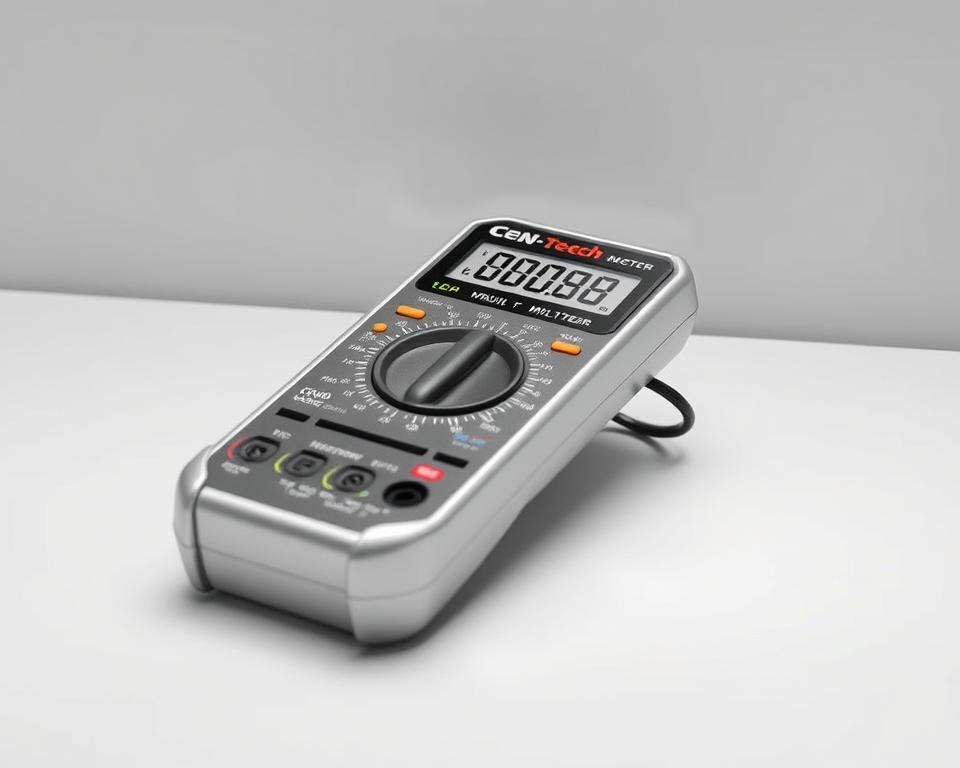Multimeter Uses: Crucial Operations Outlined
The typical multimeter can quantify up to 20V in voltage levels. Yet many endeavors, especially in modern creativity and electronics, use less than 200mA of current. This fact emphasizes the vital role multimeters serve in electronic diagnostics and problem resolution. Understanding how to handle a multimeter is vital, not just for technicians and engineers, but also for pupils examining circuit theories.
Multimeters are irreplaceable in their adaptability, offering precise measurements of electrical potential, current, and resistance. This write-up will explore the various roles and functions of a Cen-Tech 7-function digital multimeter. It intends to furnish you with the knowledge to successfully operate this critical tool in your electrical experiments and endeavors.
Principal Conclusions
- Multimeters are vital devices for gauging voltage, current, and resistance.
- Understanding multimeter applications is vital for efficient troubleshooting.
- Digital multimeters are popular for their clarity and precision in readings.
- Safety protocols are essential when using a multimeter for circuit diagnostics.
- Continuity testing is an important feature for checking electrical connections.
- Selecting the proper multimeter can notably impact your evaluation effectiveness.
Introduction to Multimeters
A multimeter is vital for diagnosing circuit issues and guaranteeing devices operate correctly. It gauges various electrical characteristics, indispensable for both specialists and hobbyists.
Definition of a Multimeter?
A multimeter integrates tools to measure electrical potential, current, and resistance. This aids substantially in solving electrical issues. Available in traditional and digital versions, multimeters are essential. Analog types use a needle and scale for readings, whereas digital ones display values on a display. They test wall outlets, batteries, and various gadgets.
Significance of Multimeter in Electrical Testing
In electrical testing, the role of a multimeter is paramount. It checks circuit integrity and pinpoints faults in various contexts. For instance, in the car industry, it examines battery potential and sensors. It also guarantees industrial machinery runs efficiently, preventing pricey malfunctions.
Multimeters, crucial for testing, measure AC and DC voltage, current, and resistance. Their ability to manage diverse tasks makes them invaluable for both straightforward and advanced projects.
Categories of Multimeters
Understanding the different types of multimeters is essential for successful electrical testing. They are divided into two primary categories: analog and digital multimeters. Each offers distinct characteristics and advantages. Therefore, selecting the right type is determined by your specific requirements and preferences.
Traditional Multimeters
Analog multimeters include a pointer needle and dial display. They are superb for tracking rapidly shifting measurements. Their configuration lets users to witness variations as they happen. Analog devices offer a detection range typically between 1,000 to 50,000 ohms per volt, with the highest sensitivity attaining 20,000 Ω/V. This rendered them preferred tools for RF specialists in the mid-century period.

Digital Multimeters
Due to their precision and capability, digital multimeters have evolved into highly favored. Their LCDs display measurements distinctly and can show up to four digits. They can measure diverse parameters like voltage and heat level. Furthermore, advanced models offer auto range, data recording, and wireless connectivity. This positions them as ideal for intricate tasks in fields like car troubleshooting and renewable energy.
Evaluation of Analog and Electronic Multimeters
Choosing between traditional and electronic multimeters depends on your particular needs and financial plan. The table below summarizes their major contrasts:
| Attribute | Analog Multimeters | Digital Multimeters |
|---|---|---|
| Visual Output | Needle pointer on scale | Digital readout (LCD) |
| Accuracy | Adequate, but somewhat lower in precision | Superior accuracy and resolution |
| Reaction Time | Swift response to fluctuations | Depends on data acquisition speed |
| Applications | Ideal for quickly varying values | Versatile, used across various sectors |
| Price | Usually more affordable | Fluctuates considerably, but can be more costly |
Although both multimeter types are vital for electrical testing, digital multimeters’ accuracy and performance have made them more popular among users in both home and professional spaces.
Parts of a Multimeter
Grasping the key elements of a multimeter is vital for its effective use. It comprises multiple main components, each with a specific role. The visual panel shows readings, while the selection knob enables users to alternate between functions like voltage, current, and resistance. Probes attach the device to the circuit being evaluated, marking another vital feature.
Key Parts and Their Operations
The primary components of a multimeter are segmented into:
- Visual Interface: Exhibits measurement results in real-time for easy data interpretation.
- Function Selector: Lets users choose the measurement type, including voltage, current, or resistance functions.
- Ports: Usually three, but some models have 4 for linking various probes.
- Test Probes: Essential for connecting the multimeter to electrical systems, with red for positive and black for ground connections.
Understanding Multimeter Probes
Probes serve a critical function in multimeter operation. They are offered in different types, such as standard or alligator clips. The red probe is designated for testing voltage or resistance; the black serves as a ground. Using alligator clips streamlines tasks pertaining to several components, improving measurement accuracy and productivity.
How the Selection Knob Works
The selection knob is essential for accessing the device’s features. By twisting the knob, users can toggle among AC and DC voltage assessments, current measurement, or resistance testing. Choosing the proper setting is essential for accurate readings. Users must exercise caution with the range setting to avert device malfunction or miscalculations.
Operations of a Multimeter
For anyone participating in electrical testing, knowing the multimeter’s functions is crucial. These devices deliver essential assessments for precisely assessing electrical elements. They gauge voltage, examine current, and check resistance, establishing their importance for both commercial applications and DIY projects.
Measuring AC and DC Voltage
Measuring both AC and DC voltage is a core function of multimeters. They deliver superior accuracy, with the ability to notice slight changes. This is vital for guaranteeing that electrical devices run safely within their voltage limits.
Assessing Current Measurement
Current measurement is more intricate than voltage. You must break the circuit path where you want to assess, as the multimeter integrates into the circuit in series. Choose the proper range, marked in amps or milliamps. Securely attach the multimeter probes between the discontinuities of the circuit.
Understanding Resistance Measurement
Testing component functionality, like resistors and capacitors, is performed via resistance measurement. Multimeters can measure resistance up to several megaohms, which is crucial for evaluating circuit integrity and executing continuity tests.
Continuity Testing Capabilities
Continuity testing is crucial for troubleshooting. It utilizes audio signals or visual signals to indicate electrical connections. This helps ensure that circuits operate as designed, facilitating streamlined fault finding.
| Capability | Traditional Multimeters | Electronic Multimeters |
|---|---|---|
| Voltage Assessment | Measures AC and DC voltage with remarkable exactness | Evaluating power supply in devices |
| Current Measurement | Assesses electrical flow in circuits | Checking battery voltage and sensor functionality |
| Resistance Measurement | Tests the performance of circuit components | Ensuring resistors and diodes are within acceptable ranges |
| Continuity Testing | Assesses electrical connections | Diagnosing circuit integrity |
Operating a Multimeter Securely and Effectively
Understanding how to handle a multimeter is crucial for anyone working with electrical systems. Proper procedures secure protection and measurement accuracy. When assessing voltage, current, or resistance, each step requires certain precautions.
Basic Safety Measures
Acquiring safety guidelines before using a multimeter is critical. Your multimeter should be suitable for your operating conditions. Regrettably, over thirty percent of electricians use inadequately rated tools, risking danger. To operate safely, always verify the multimeter is accurately adjusted before connecting probes.
How to Measure Voltage
Measuring voltage requires meticulousness. First, choose the appropriate multimeter range for the voltage, AC or DC. Insert the probes into the designated ports: the common and voltage-specific jacks. Then, attach the probes correctly to the circuit.
How to Measure Current
Current measurement is more intricate than voltage. You must interrupt the circuit path where you want to determine, as the multimeter is connected in series. Choose the appropriate range, marked in amperes or milliamps. Securely attach the multimeter probes between the discontinuities of the circuit.
Procedure for Evaluating Resistance
To correctly assess resistance, detach the component in question. Switch the multimeter to resistance mode, then attach the probes to the component. A matching reading indicates that the component works well; otherwise, it might be defective. This precaution helps avoid multimeter damage and guarantees accurate electrical flow analysis.
Frequent Uses of Multimeters
Multimeters are indispensable in both industrial and residential environments for a variety of functions. They shine in diagnosing electrical circuits, establishing their indispensability. These devices are crucial in identifying and correcting electrical problems, securing systems function properly.
Troubleshooting Electrical Issues
Multimeters primarily are used to detect electrical circuit issues. Technicians and DIY enthusiasts rely on them to locate problems. By measuring voltage, current, and resistance, they find faulty parts, guaranteeing proper operation.
Assessing Batteries and Electrical Sources
Testing batteries is a crucial application for multimeters. They gauge voltage to determine automotive or household battery charge status. This allows users to ascertain if a battery is functioning properly or needs changing, improving energy management.
Checking Circuit Integrity
For security and efficiency, verifying circuit integrity is key. Multimeters assess this by testing continuity and resistance. They identify issues such as broken wires or defects, resulting in timely fixes. Overall, multimeters enhance both the safety of installations and circuit troubleshooting.
Selecting the Appropriate Multimeter for Your Needs
Selecting the right multimeter boosts your productivity in electrical testing. Key factors to consider include precision, measurement options, compactness, and ease of use. Unlike analog meters, digital multimeters outperform in functionality, preferred by technicians and hobbyists.
Factors to Consider
Essential factors in selecting a multimeter include:
- Accuracy: Digital multimeters provide exceptional accuracy, sensing variations as small as 1 millivolt.
- Measurement Ranges: Opt for models that manage diverse electrical metrics like voltage, current, and resistance.
- Mobility: Select small, convenient designs for on-site tasks.
- User-Friendliness: Auto-ranging and illuminated screens enhance a better user experience.
Popular Models: Cen-Tech 7 Function Digital Multimeter
The Cen-Tech 7 Function Digital Multimeter is recognized for its adaptability and affordability. It combines key features suited for both novices and experts. Additionally, its automatic ranging feature streamlines measurements, streamlining task execution.
This model’s count capacity reaches up to 20,000, promising accurate measurements for a diverse electrical jobs. It excels in troubleshooting, automotive tests, and battery checks. Its mix of essential features and simplicity of use makes the Cen-Tech 7 Function Digital Multimeter a preferred option for a new investment.
In Summary
Grasping multimeter functions is crucial for those participating in electrical tasks. We’ve encapsulated multimeter applications, showcasing their value in testing and safety. Their precision in assessing voltage, current, and resistance is irreplaceable. Thus, multimeters are essential for both experts and enthusiasts.
Multimeters exceed mere assessments. They provide advanced capabilities like data logging and wireless connections. These features enable wide-ranging applications, from car diagnostics to exploiting renewable energy. Additionally, capabilities for continuity and frequency checks are instrumental in detecting defects, ensuring systems function reliably.
Armed with this knowledge, individuals can effectively utilize their multimeter proficiency for accurate fault detection and boosting protection. They can also boost the efficiency of electrical setups and upkeep. Essentially, multimeters’ adaptability renders them irreplaceable in achieving meticulousness in electrical jobs.
Frequently Asked Questions
What core operations does a multimeter perform?
A multimeter primarily measures voltage (AC and DC), current, and resistance. It also executes continuity tests. These operations are vital for detecting electrical faults and assessing system integrity.
How should I decide between analog and digital multimeters?
Choosing between analog and digital multimeters relies on your needs. Analog types are great for showing swift changes in value. In contrast, digital models deliver accurate digital outputs. This renders them favored for daily tasks.
What safety precautions should I take when using a multimeter?
When using a multimeter, always choose the appropriate mode before connecting. Do not contact live circuits when measuring current. Also, isolate sections before resistance tests to minimize inaccurate readings.
Is it possible for a multimeter to evaluate batteries?
Yes, battery testing is a frequent application for multimeters. They gauge voltage to show charge level. This guarantees that your power sources are reliable for various needs.
What is continuity testing, and why is it important?
Continuity testing assesses electrical connections in a circuit using a multimeter. It’s vital for locating faults and restoring connections. This ensures that your electrical setups function properly.
What are the typical components found in a multimeter?
A multimeter typically includes a visual output, a selection knob, input terminals, and the probes. The probes make contact with the circuit being tested.
How does the Cen-Tech 7 Function Digital Multimeter measure up against other options?
The Cen-Tech 7 Function Digital Multimeter is user-friendly and delivers flexible features, including auto-ranging. It’s economically priced, making it a solid option for specialists and enthusiasts.

